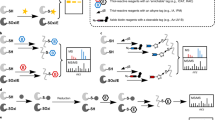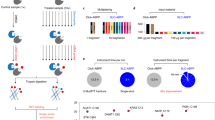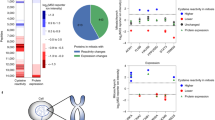Abstract
Cysteine is the most intrinsically nucleophilic amino acid in proteins, where its reactivity is tuned to perform diverse biochemical functions. The absence of a consensus sequence that defines functional cysteines in proteins has hindered their discovery and characterization. Here we describe a proteomics method to profile quantitatively the intrinsic reactivity of cysteine residues en masse directly in native biological systems. Hyper-reactivity was a rare feature among cysteines and it was found to specify a wide range of activities, including nucleophilic and reductive catalysis and sites of oxidative modification. Hyper-reactive cysteines were identified in several proteins of uncharacterized function, including a residue conserved across eukaryotic phylogeny that we show is required for yeast viability and is involved in iron-sulphur protein biogenesis. We also demonstrate that quantitative reactivity profiling can form the basis for screening and functional assignment of cysteines in computationally designed proteins, where it discriminated catalytically active from inactive cysteine hydrolase designs.
This is a preview of subscription content, access via your institution
Access options
Subscribe to this journal
Receive 51 print issues and online access
$199.00 per year
only $3.90 per issue
Buy this article
- Purchase on Springer Link
- Instant access to full article PDF
Prices may be subject to local taxes which are calculated during checkout





Similar content being viewed by others
Accession codes
References
Eisenberg, D., Marcotte, E. M., Xenarios, I. & Yeates, T. O. Protein function in the post-genomic era. Nature 405, 823–826 (2000)
Zhao, Y. & Jensen, O. N. Modification-specific proteomics: strategies for characterization of post-translational modifications using enrichment techniques. Proteomics 9, 4632–4641 (2009)
Bulaj, G., Kortemme, T. & Goldenberg, D. P. Ionization reactivity relationships for cysteine thiols in polypeptides. Biochemistry 37, 8965–8972 (1998)
Giles, N. M., Giles, G. I. & Jacob, C. Multiple roles of cysteine in biocatalysis. Biochem. Biophys. Res. Commun. 300, 1–4 (2003)
Reddie, K. G. & Carroll, K. S. Expanding the functional diversity of proteins through cysteine oxidation. Curr. Opin. Chem. Biol. 12, 746–754 (2008)
Voss, A. A., Lango, J., Ernst-Russell, M., Morin, D. & Pessah, I. N. Identification of hyperreactive cysteines within ryanodine receptor type 1 by mass spectrometry. J. Biol. Chem. 279, 34514–34520 (2004)
Lewis, C. T., Seyer, J. M. & Carlson, G. M. Cysteine 288: an essential hyperreactive thiol of cytosolic phosphoenolpyruvate carboxykinase (GTP). J. Biol. Chem. 264, 27–33 (1989)
Knowles, J. R. Intrinsic pK a-values of functional-groups in enzymes: improper deductions from pH-dependence of steady-state parameters. CRC Crit. Rev. Biochem. 4, 165–173 (1976)
Fomenko, D. E., Xing, W., Adair, B. M., Thomas, D. J. & Gladyshev, V. N. High-throughput identification of catalytic redox-active cysteine residues. Science 315, 387–389 (2007)
Sethuraman, M. et al. Isotope-coded affinity tag (ICAT) approach to redox proteomics: identification and quantitation of oxidant-sensitive cysteine thiols in complex protein mixtures. J. Proteome Res. 3, 1228–1233 (2004)
Baty, J. W., Hampton, M. B. & Winterbourn, C. C. Proteomic detection of hydrogen peroxide-sensitive thiol proteins in Jurkat cells. Biochem. J. 389, 785–795 (2005)
Salsbury, F. R., Jr, Knutson, S. T., Poole, L. B. & Fetrow, J. S. Functional site profiling and electrostatic analysis of cysteines modifiable to cysteine sulfenic acid. Protein Sci. 17, 299–312 (2008)
Leonard, S. E., Reddie, K. G. & Carroll, K. S. Mining the thiol proteome for sulfenic acid modifications reveals new targets for oxidation in cells. ACS Chem. Biol. 4, 783–799 (2009)
Kim, J.-R., Yoon, H. W., Kwon, K.-S., Lee, S.-R. & Rhee, S. G. Identification of proteins containing cysteine residues that are sensitive to oxidation by hydrogen peroxide at neutral pH. Anal. Biochem. 283, 214–221 (2000)
Speers, A. E. & Cravatt, B. F. A tandem orthogonal proteolysis strategy for high-content chemical proteomics. J. Am. Chem. Soc. 127, 10018–10019 (2005)
Weerapana, E., Simon, G. M. & Cravatt, B. F. Disparate proteome reactivity profiles of carbon electrophiles. Nature Chem. Biol. 4, 405–407 (2008)
Dennehy, M. K., Richards, K. A., Wernke, G. R., Shyr, Y. & Liebler, D. C. Cytosolic and nuclear protein targets of thiol-reactive electrophiles. Chem. Res. Toxicol. 19, 20–29 (2006)
Shin, N.-Y., Liu, Q., Stamer, S. L. & Liebler, D. C. Protein targets of reactive electrophiles in human liver microsomes. Chem. Res. Toxicol. 20, 859–867 (2007)
Speers, A. E., Adam, G. C. & Cravatt, B. F. Activity-based protein profiling in vivo using a copper(I)-catalyzed azide-alkyne [3 + 2] cycloaddition. J. Am. Chem. Soc. 125, 4686–4687 (2003)
Weerapana, E., Speers, A. E. & Cravatt, B. F. Tandem orthogonal proteolysis-activity-based protein profiling (TOP-ABPP)—a general method for mapping sites of probe modification in proteomes. Nature Protocols 2, 1414–1425 (2007)
Shiio, Y. & Aebersold, R. Quantitative proteome analysis using isotope-coded affinity tags and mass spectrometry. Nature Protocols 1, 139–145 (2006)
Board, P. G. et al. Identification, characterization, and crystal structure of the omega class glutathione transferases. J. Biol. Chem. 275, 24798–24806 (2000)
Thompson, S. et al. Mechanistic studies on β-ketoacyl thiolase from Zoogloea ramigera: identification of the active-site nucleophile as Cys89, its mutation to Ser89, and kinetic and thermodynamic characterization of wild-type and mutant enzymes. Biochemistry 28, 5735–5742 (1989)
Iyer, L. M., Koonin, E. V. & Aravind, L. Novel predicted peptidases with a potential role in the ubiquitin signaling pathway. Cell Cycle 3, 1440–1450 (2004)
Codreanu, S. G., Zhang, B., Sobecki, S. M., Billheimer, D. D. & Liebler, D. C. Global analysis of protein damage by the lipid electrophile 4-hydroxy-2-nonenal. Mol. Cell. Proteomics 8, 670–680 (2009)
Zhang, X. & Cheng, X. Structure of the predominant protein arginine methyltransferase PRMT1 and analysis of Its binding to substrate peptides. Structure 11, 509–520 (2003)
Harrop, S. J. et al. Crystal structure of a soluble form of the intracellular chloride ion channel CLIC1 (NCC27) at 1.4-Å resolution. J. Biol. Chem. 276, 44993–45000 (2001)
Hao, G., Derakhshan, B., Shi, L., Campagne, F. & Gross, S. S. SNOSID, a proteomic method for identification of cysteine S-nitrosylation sites in complex protein mixtures. Proc. Natl Acad. Sci. USA 103, 1012–1017 (2006)
Giaever, G. et al. Functional profiling of the Saccharomyces cerevisiae genome. Nature 418, 387–391 (2002)
Lill, R. Function and biogenesis of iron sulphur proteins. Nature 460, 831–838 (2009)
Pierik, A. J., Netz, D. J. & Lill, R. Analysis of iron–sulfur protein maturation in eukaryotes. Nature Protocols 4, 753–766 (2009)
Netz, D. J. A., Pierik, A. J., Stumpfig, M., Muhlenhoff, U. & Lill, R. The Cfd1–Nbp35 complex acts as a scaffold for iron-sulfur protein assembly in the yeast cytosol. Nature Chem. Biol. 3, 278–286 (2007)
Okerberg, E. S. et al. High-resolution functional proteomics by active-site peptide profiling. Proc. Natl Acad. Sci. USA 102, 4996–5001 (2005)
Nazif, T. & Bogyo, M. Global analysis of proteasomal substrate specificity using positional-scanning libraries of covalent inhibitors. Proc. Natl Acad. Sci. USA 98, 2967–2972 (2001)
Chen, G. et al. Reactivity of functional groups on the protein surface: development of epoxide probes for protein labeling. J. Am. Chem. Soc. 125, 8130–8133 (2003)
Silverman, J. A. & Harbury, P. B. Rapid mapping of protein structure, interactions, and ligand binding by misincorporation proton-alkyl exchange. J. Biol. Chem. 277, 30968–30975 (2002)
Isom, D. G., Vardy, E., Oas, T. G. & Hellinga, H. W. Picomole-scale characterization of protein stability and function by quantitative cysteine reactivity. Proc. Natl Acad. Sci. USA 107, 4908–4913 (2010)
Kortemme, T. & Creighton, T. E. Ionisation of cysteine residues at the termini of model α-helical peptides. Relevance to unusual thiol pK a values in proteins of the thioredoxin family. J. Mol. Biol. 253, 799–812 (1995)
Macpherson, L. J. et al. Noxious compounds activate TRPA1 ion channels through covalent modification of cysteines. Nature 445, 541–545 (2007)
Eng, J. K., Mccormack, A. L. & Yates, J. R. An approach to correlate tandem mass-spectral data of peptides with amino-acid-sequences in a protein database. J. Am. Soc. Mass Spectrom. 5, 976–989 (1994)
Kispal, G., Csere, P., Prohl, C. & Lill, R. The mitochondrial proteins Atm1p and Nfs1p are essential for biogenesis of cytosolic Fe/S proteins. EMBO J. 18, 3981–3989 (1999)
Tabb, D. L., McDonald, W. H. & Yates, J. R., III DTASelect and Contrast: tools for assembling and comparing protein identifications from shotgun proteomics. J. Proteome Res. 1, 21–26 (2002)
Elias, J. E. & Gygi, S. P. Target-decoy search strategy for increased confidence in large-scale protein identifications by mass spectrometry. Nature Methods 4, 207–214 (2007)
Collins, S. R. et al. Toward a comprehensive atlas of the physical interactome of Saccharomyces cerevisiae . Mol. Cell. Proteomics 6, 439–450 (2007)
Pedrioli, P. G. A. et al. A common open representation of mass spectrometry data and its application to proteomics research. Nature Biotechnol. 22, 1459–1466 (2004)
Park, S. K., Venable, J. D., Xu, T. & Yates, J. R. A quantitative analysis software tool for mass spectrometry-based proteomics. Nature Methods 5, 319–322 (2008)
Vallee, B. L. & Hoch, F. L. Zinc, a component of yeast alcohol dehydrogenase. Proc. Natl Acad. Sci. USA 41, 327–338 (1955)
Zanghellini, A. et al. New algorithms and an in silico benchmark for computational enzyme design. Protein Sci. 15, 2785–2794 (2006)
Ma, S., Devi-Kesavan, L. S. & Gao, J. Molecular dynamics simulations of the catalytic pathway of a cysteine protease: a combined QM/MM study of human cathepsin K. J. Am. Chem. Soc. 129, 13633–13645 (2007)
Jiang, L. et al. De novo computational design of retro-aldol enzymes. Science 319, 1387–1391 (2008)
Acknowledgements
We would like to thank T. Bartfai, I. Wilson and members of the B.F.C. laboratory for comments and critical reading of the manuscript, T. Ji for experimental assistance and J. Gallaher for expression of designed proteins. This work was supported by the National Institutes of Health (CA087660, MH084512), a Pfizer Postdoctoral Fellowship (E.W.), a Koshland Graduate Fellowship in Enzyme Biochemistry (G.M.S.), a National Science Foundation predoctoral fellowship (D.A.B.) and the Skaggs Institute for Chemical Biology.
Author information
Authors and Affiliations
Contributions
B.F.C., E.W. and C.W. conceived the project and E.W. and C.W. performed MS experiments and yeast growth/Leu1 assays. C.W. and G.M.S. performed computational data analyses. S.K., F.R. and D.B. performed computational design of cysteine hydrolases and measured activity using a fluorogenic assay. D.A.B. purified PRMT1 and M.B.D.D. and K.M. performed PRMT1 activity assays. B.F.C., E.W., C.W. and G.M.S. analysed data and wrote the manuscript.
Corresponding author
Ethics declarations
Competing interests
The authors declare no competing financial interests.
Supplementary information
Supplementary Information
The file contains a Supplementary Discussion, Supplementary Methods, Supplementary Figures 1-18 with legends, Supplementary Tables 1-8 and additional references. (PDF 6480 kb)
Supplementary Table
The file contains Supplementary Table 9. (XLS 7446 kb)
Rights and permissions
About this article
Cite this article
Weerapana, E., Wang, C., Simon, G. et al. Quantitative reactivity profiling predicts functional cysteines in proteomes. Nature 468, 790–795 (2010). https://doi.org/10.1038/nature09472
Received:
Accepted:
Published:
Issue Date:
DOI: https://doi.org/10.1038/nature09472
This article is cited by
-
A chemical proteomics approach for global mapping of functional lysines on cell surface of living cell
Nature Communications (2024)
-
Enhanced mapping of small-molecule binding sites in cells
Nature Chemical Biology (2024)
-
On-Off-On Fluorometric Detection of Hg(II) and L-Cysteine Using Red Emissive Nitrogen-Doped Carbon Dots for Environmental and Clinical Sample Analysis
Journal of Fluorescence (2024)
-
Selective and sensitive detection of aqueous contaminants via coinage metal-enhanced fluorescence with diiminic Schiff bases
International Journal of Environmental Science and Technology (2024)
-
Dual Fluorimetric Sensor for Tandem Detection of Cadmium and Cysteine: An Approach for Designing a Molecular Keypad Lock System
Journal of Fluorescence (2024)
Comments
By submitting a comment you agree to abide by our Terms and Community Guidelines. If you find something abusive or that does not comply with our terms or guidelines please flag it as inappropriate.



